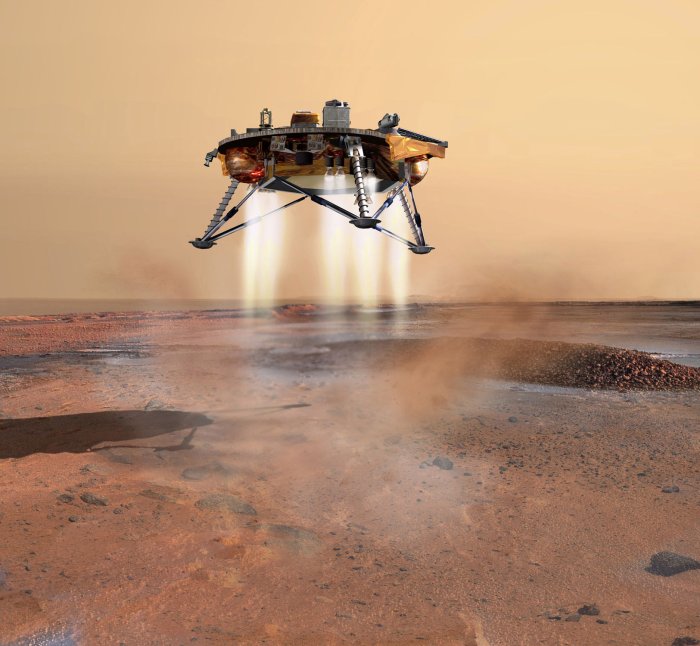Updated: May 27, 2008 at 11:02 AM
Mars Phoenix Lander (17 images)

This artist's concept depicts NASA's Phoenix Mars Lander a moment before its 2008 touchdown on the arctic plains of Mars. Pulsed rocket engines control the spacecraft's speed during the final seconds of descent. Phoenix touched down on the Red Planet at 4:53 p.m. Pacific Time (7:53 p.m. Eastern Time), May 25, 2008, in an arctic region called Vastitas Borealis, at 68 degrees north latitude, 234 degrees east longitude. (UPI Photo/NASA/JPL-Calech/University of Arizona)
License photo | Permalink

The Robotic Arm Camera on NASA's Phoenix Mars Lander captured this image underneath the lander on the fifth Martian day, or sol, of the mission. Descent thrusters on the bottom of the lander are visible at the top of the image. This view from the north side of the lander toward the southern leg shows smooth surfaces cleared from overlying soil by the rocket exhaust during landing. One exposed edge of the underlying material was seen in Sol 4 images, but the newer image reveals a greater extent of it. The abundance of excavated smooth and level surfaces adds evidence to a hypothesis that the underlying material is an ice table covered by a thin blanket of soil. The bright-looking surface material in the center, where the image is partly overexposed, may not be inherently brighter than the foreground material in shadow. (UPI Photo/NASA/JPL-Calech/University of Arizona/Max Planck Institute)
License photo | Permalink

This image from NASA's Phoenix Mars Lander's Robotic Arm Camera (RAC) shows material from the Martian surface captured by the Robotic Arm (RA) scoop during its first test dig and dump on the seventh Martian day of the mission, or Sol 7 (June 1, 2008). The test sample shown was taken from the digging area informally known as "Knave of Hearts." Scientists speculate that the white patches on the right side of the image could possibly be ice or salts that precipitated into the soil. Scientists also speculate that this white material is probably the same material seen in previous images from under the lander in which an upper surface of an ice table was observed. The color for this image was acquired by illuminating the RA scoop with a set of red, green, and blue light-emitting diodes (LEDs). (UPI Photo/NASA/JPL-Calech/University of Arizona/Max Planck Institute)
License photo | Permalink

This color image, acquired by NASA's Phoenix Mars Lander's Surface Stereo Imager on Sol 7, the seventh day of the mission (June 1, 2008), shows the so-called "Knave of Hearts" first-dig test area to the north of the lander. The Robotic Arm's scraping blade left a small horizontal depression above where the sample was taken. (UPI Photo/NASA/JPL-Calech/University of Arizona)
License photo | Permalink
Advertisement